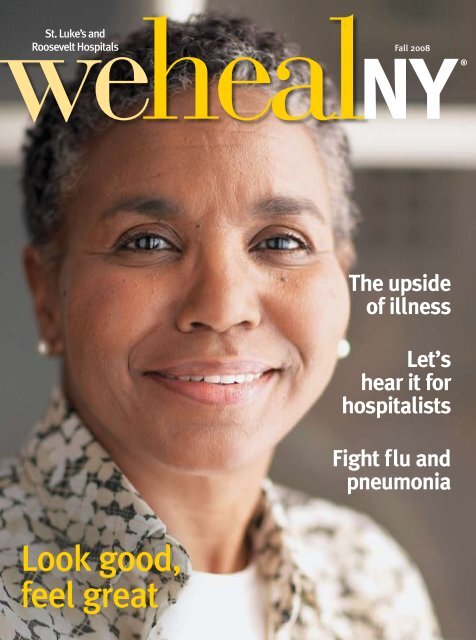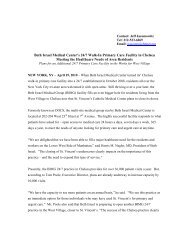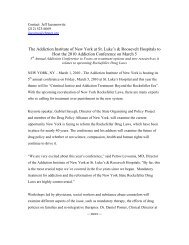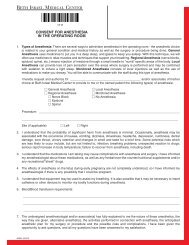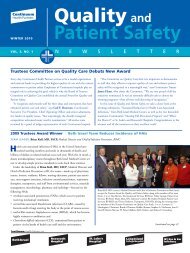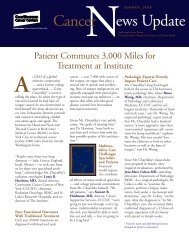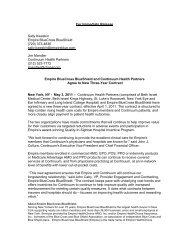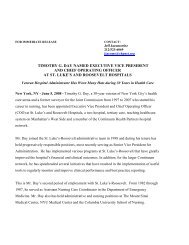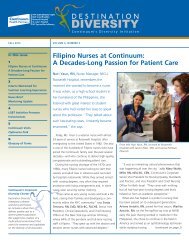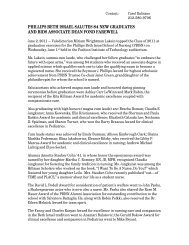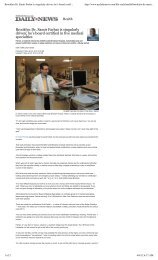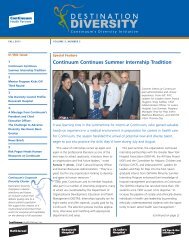Look good, feel great - Continuum Health Partners
Look good, feel great - Continuum Health Partners
Look good, feel great - Continuum Health Partners
You also want an ePaper? Increase the reach of your titles
YUMPU automatically turns print PDFs into web optimized ePapers that Google loves.
St. Luke’s and<br />
Roosevelt Hospitals<br />
Fall 2008<br />
ehealny®<br />
<strong>Look</strong> <strong>good</strong>,<br />
<strong>feel</strong> <strong>great</strong><br />
The upside<br />
of illness<br />
Let’s<br />
hear it for<br />
hospitalists<br />
Fight flu and<br />
pneumonia
wehealny<br />
To our readers<br />
Autumn is here, and<br />
that means winter illness<br />
aren’t far behind.<br />
Older adults in particular<br />
are susceptible<br />
to flu and pneumonia,<br />
but with a healthy<br />
dose of prevention,<br />
you can guard against these conditions.<br />
Read “Defend yourself” on this<br />
page to find out how.<br />
In this issue of We Heal New York,<br />
you’ll also learn about the different<br />
health care providers you may<br />
come in contact with at St. Luke’s and<br />
Roosevelt Hospitals, including nurse<br />
practitioner Eileen Quinlan, GNP, BC,<br />
hospitalist Raj Gurunathan, MD, and<br />
physician assistant Danielle Witman.<br />
Each of these individuals plays a<br />
key role in helping our patients stay<br />
healthy and cared for, both in and out<br />
of the hospital setting.<br />
We’re in your corner<br />
Whether you need a primary care provider,<br />
a specialist or specialty health<br />
services, you’ll find them at St. Luke’s<br />
and Roosevelt Hospitals. Call our physician<br />
referral line at 1 (800) 420-2462.<br />
We want your<br />
feedback!<br />
We Heal New York welcomes<br />
questions, comments and story<br />
suggestions. Write to us at:<br />
We Heal New York<br />
c/o Public Affairs and Marketing<br />
<strong>Continuum</strong> <strong>Health</strong> <strong>Partners</strong><br />
555 W. 57th St., 18th Floor<br />
New York, NY 10019<br />
e-mail: GFessenden@chpnet.org<br />
View a PDF of this issue online at<br />
www.WeHealNewYork.org/SLR.<br />
2 wehealny<br />
Frank J. Cracolici,<br />
President, St. Luke’s<br />
and Roosevelt<br />
Hospitals<br />
Mark Gorny, MD<br />
Defend<br />
yourself<br />
Your guide to preventing<br />
flu and pneumonia<br />
If you’re one of many Americans<br />
who thinks you’re<br />
immune to infectious<br />
diseases like the flu and<br />
pneumonia, you may be putting<br />
yourself at risk for serious illness.<br />
Older adults often overlook the<br />
complications that can result from<br />
colds and flu, such as bronchitis<br />
and pneumonia, but as you age,<br />
you face a higher risk for developing<br />
these conditions. Your risk for<br />
complications also rises if you:<br />
• have a chronic health condition<br />
such as diabetes, cardio-<br />
vascular disease or lung disease<br />
• have an impaired immune<br />
system<br />
• are being treated for cancer<br />
• live in a nursing home or<br />
other institution<br />
The <strong>good</strong> news is that with<br />
<strong>good</strong> care and prevention, you<br />
won’t have to worry about these<br />
conditions. Read on to learn how<br />
to protect yourself from the flu<br />
and pneumonia this season.<br />
Get a shot of<br />
<strong>good</strong> health!<br />
To find a doctor who can give you<br />
the vaccinations you need, call<br />
1 (800) 420-2462.
John Greely, MD<br />
Fighting flu<br />
Influenza is a viral infection of<br />
the nose, throat, bronchial tubes<br />
and lungs. Symptoms include runny<br />
nose, coughing, sneezing, sore throat,<br />
fever of 101˚ F or higher, chills, body<br />
aches, appetite loss, fatigue and weakness.<br />
“See your doctor right away if<br />
you have flu symptoms,” says John<br />
Greely, MD, a board-certified internal<br />
medicine physician at St. Luke’s<br />
and Roosevelt Hospitals. “A prescription<br />
antiviral medication, taken<br />
within 48 hours of the symptoms’<br />
onset, can help the body fight off the<br />
flu in addition to the body’s natural<br />
defenses.”<br />
Sound nutrition and regular exercise<br />
can strengthen your immune<br />
system to fight infectious diseases,<br />
and regular hand washing can keep<br />
germs at bay. Annual flu shots will<br />
give you added protection and are<br />
recommended for adults ages 50 and<br />
older. Because new strains appear<br />
each year, the vaccine is reformulated<br />
to fight the three strains expected to<br />
be most active. “The best time to get<br />
vaccinated is in October or<br />
November, so you’ll be protected<br />
throughout the winter season,”<br />
advises Dr. Greely.<br />
Nixing pneumonia<br />
Adults ages 65 and older have an<br />
increased risk of pneumonia, a lung<br />
infection and inflammation that<br />
often stems from a cold or the flu.<br />
More than 50 kinds of pneumonia<br />
exist, caused by bacteria, viruses (the<br />
same ones that can cause flu), fungi<br />
and other organisms.<br />
“Pneumonia can be a serious and<br />
potentially fatal illness, especially<br />
in older adults, since their immune<br />
system may not be as robust as a<br />
younger person’s,” says Mark Gorny,<br />
MD, an internal medicine physician<br />
at St. Luke’s and Roosevelt Hospitals.<br />
That’s why it’s important to see your<br />
doctor at the first sign of symptoms<br />
such as chills, fever, sweating, chest<br />
pain, cough and shortness of breath.<br />
Prompt treatment can minimize complications.<br />
Depending on the type of<br />
Be wise—immunize<br />
pneumonia you have, your physician<br />
may prescribe antibiotics or antivirals<br />
and instruct you to rest until you’ve<br />
recovered.<br />
Better yet, getting an annual<br />
flu shot and a pneumonia vaccination<br />
can help prevent pneumonia.<br />
“Immunization against pneumococcal<br />
pneumonia is recommended for<br />
adults ages 65 and older,” Dr. Gorny<br />
says. You only need one pneumonia<br />
vaccination, and you can get it all<br />
year long (not just during flu season).<br />
Aside from having little to no side<br />
effects, Dr. Gorny points out the<br />
vaccine’s benefits far outweigh the<br />
risks of developing pneumonia. “It’s<br />
a lot easier to get the vaccine than<br />
to deal with the illness itself later,”<br />
he says.<br />
You can also keep your immune<br />
system strong with a healthy diet<br />
and regular exercise. Get in the habit<br />
of regular hand washing and if you<br />
smoke, quit, since smoking makes<br />
your lungs more vulnerable to<br />
respiratory infection.<br />
If you’re not adequately immunized, you could be susceptible to preventable<br />
illness. Drs. Greely and Gorny recommend these immunizations for healthy<br />
older adults. (Ask your doctor about your risk factors and specific needs.)<br />
IMMunIzaTIon Frequency<br />
ÑTetanus, diphtheria, pertussis (Td/Tdap) Once every 10 years<br />
ÑInfluenza Every year<br />
ÑPneumococcal polysaccharide (pneumonia) Once at age 65 or older*<br />
ÑZoster (shingles) Once at age 60 or older<br />
* Adults who received this vaccine before age 65 due to a higher individual risk should<br />
receive a one-time revaccination if five years have passed and they’re now 65 or older.<br />
Fall 2008 3
If you’re sick or in need of a<br />
regular checkup and screenings,<br />
you normally make<br />
an appointment to see your<br />
physician. But did you know that a<br />
nurse practitioner can also work with<br />
you to help you stay healthy?<br />
That’s because nurse practitioners<br />
have the expertise to examine and<br />
treat patients who have acute and<br />
chronic medical problems. Just ask<br />
Eileen Quinlan, GNP, BC, a geriatric<br />
nurse practitioner at St. Luke’s<br />
and Roosevelt Hospitals. Quinlan<br />
is a member of University Medical<br />
Practice Associates’ location across<br />
the street from St. Luke’s Hospital.<br />
(UMPA has two additional Upper<br />
West Side locations.) “I’m the primary<br />
care provider for my patients,”<br />
she says. Quinlan cares for patients<br />
similar to the way physicians do.<br />
What is a nurse practitioner?<br />
A nurse practitioner is a registered<br />
nurse who has completed a master’s<br />
4 wehealny<br />
Greta Weinberg<br />
program in a particular specialty, like<br />
geriatrics, and achieved national certification<br />
and state licensure.<br />
“A nurse practitioner brings a<br />
background in nursing to her patient<br />
care and is trained at an advanced<br />
level to diagnose and treat common<br />
chronic and acute problems,” Quinlan<br />
says. Similar to physicians, nurse<br />
practitioners are also authorized to<br />
prescribe medications to patients.<br />
Understanding patients’ needs<br />
Older adults have unique health<br />
care needs, and Quinlan makes a<br />
point of addressing them with her<br />
patients. “We focus on disease prevention,<br />
promoting healthy activities and<br />
maximizing their quality of life,” she<br />
says. To that end, she also collaborates<br />
with other health care providers such<br />
as home health aides and social workers.<br />
“It’s crucial to be a team player,<br />
since older adults often have many<br />
people on their team. That’s one of<br />
my strongest suits,” says Quinlan. “I<br />
eileen quinlan,<br />
GnP, Bc<br />
Focusing on YOU<br />
Nurse practitioners offer quality medical care<br />
keep the entire team working together<br />
and with the patient.”<br />
Quinlan also draws on her experience<br />
as a child of aging adults.<br />
“I’ve been there—I understand my<br />
patients and their families professionally<br />
and personally,” says Quinlan. “I<br />
have an appreciation on a personal<br />
level of some of their issues.”<br />
Strengthening relationships<br />
One of the most satisfying things<br />
about Quinlan’s job is the one-onone<br />
relationship she builds with<br />
each patient. “I enjoy the people<br />
I care for,” she says. “In geriatrics,<br />
you develop a very close bond with<br />
patients, since health care is a big<br />
focus for them. It’s so rewarding.”<br />
Stay healthy!<br />
To find a health care provider who can<br />
care for you, call 1 (800) 420-2462.
Hospitalists:<br />
Inpatient specialists<br />
If you or a loved one have been<br />
an inpatient at St. Luke’s and<br />
Roosevelt Hospitals lately, you<br />
may have noticed the presence<br />
of senior-level physicians who<br />
coordinate all aspects of your care<br />
while you’re in the hospital. They<br />
admit you, work with your surgeon<br />
if you need surgery, communicate<br />
with your primary care physician and<br />
quickly coordinate emergency care<br />
if needed.<br />
These are just some of the<br />
responsibilities of someone called a<br />
hospitalist. “A hospitalist is a physician<br />
whose sole focus is on inpatient<br />
care,” says Raj Gurunathan, MD,<br />
one of 28 such physicians on staff at<br />
St. Luke’s and Roosevelt Hospitals<br />
and director of its hospitalist<br />
program.<br />
raj Gurunathan, MD<br />
Coordinating your care<br />
Adult hospitalists are typically<br />
internal medicine physicians—like<br />
Dr. Gurunathan—or sometimes<br />
family practitioners or medical<br />
sub-specialists who are based in the<br />
hospital. “We’re on-site full-time,<br />
allowing us more direct interaction<br />
with the patients and their families,<br />
more time to supervise and educate<br />
medical trainees, and more time to<br />
partner with surgeons and other specialists<br />
to provide a complete scope<br />
of care for patients during their hospital<br />
stay,” Dr. Gurunathan says.<br />
Traditionally, physicians have had<br />
to split their time between making<br />
rounds at the hospital and seeing<br />
patients in their office. For a busy<br />
physician and a sick patient, this<br />
schedule isn’t always practical. That’s<br />
where hospitalists come in.<br />
From admission to discharge, a<br />
hospitalist is responsible for developing<br />
a treatment plan, which includes<br />
consulting with any necessary specialists<br />
and social service staff. They help<br />
you navigate the hospital services<br />
system, answer questions about tests<br />
and procedures, arrange for any necessary<br />
emergency care and communicate<br />
with your primary care physician<br />
when you’re discharged to ensure<br />
proper follow-up care. (For patients<br />
who don’t have a primary care physician,<br />
follow-up appointments and<br />
referrals can be provided.)<br />
“Patients like that they have one<br />
point person to go to,” Dr. Gurunathan<br />
says. Physicians appreciate<br />
having a skilled colleague to care<br />
for their hospitalized patients while<br />
they’re busy in their offices.<br />
Still, some patients are apprehensive<br />
about seeing someone other than<br />
their regular physician. Their fears<br />
are quickly calmed.<br />
“We make it pretty clear to<br />
patients that we’re not replacing anybody,”<br />
Dr. Gurunathan says. “We’re<br />
part of the spectrum of care—allies<br />
of patients and their primary care<br />
doctors—and champions of better<br />
hospital care for everyone.”<br />
Need a <strong>great</strong><br />
doctor?<br />
For help finding a physician, call<br />
1 (800) 420-2462.<br />
Fall 2008 5
Seizing<br />
the day<br />
How having<br />
an illness can<br />
change your<br />
life—for the<br />
better<br />
not about how to<br />
achieve your dreams,”<br />
Randy Pausch told a<br />
“It’s<br />
captivated audience in<br />
the packed Carnegie-Mellon University<br />
lecture hall. “It’s about how<br />
you live your life. If you lead your<br />
life the right way, the karma will<br />
take care of itself. The dreams will<br />
come to you.”<br />
Stay healthy today<br />
For a referral to someone who can<br />
help you cope with these and other<br />
mental health issues, call 1 (212)<br />
523-8080.<br />
Watch Dr. Gilbert discuss “The<br />
Wisdom of Illness” at www.slrpsych.org.<br />
6 wehealny<br />
Joel Podgor<br />
The words of the celebrated 46year-old<br />
computer sciences professor,<br />
who died on July 25, 2008, and the<br />
standing ovation that followed were<br />
captured on video and posted to the<br />
popular Web site YouTube.com.<br />
While his words are moving, what’s<br />
really an inspiration to the millions<br />
who’ve heard them is that Pausch’s<br />
zest for life wasn’t diminished by the<br />
fact that he was dying. His pancreatic<br />
cancer had spread, but he was still<br />
ready to embrace every last second of<br />
his life.<br />
It may seem strange that some<br />
people who face life-threatening<br />
illnesses can be so upbeat. But ask<br />
those who’ve faced such adversity<br />
and they’ll tell you an illness can<br />
indeed be a gift.<br />
Lemons, lemonade and life<br />
Joel Podgor is a 59-year-old<br />
accountant from Queens who faced<br />
two life-threatening illnesses. He<br />
was diagnosed with embryonal cancer<br />
when he was 23 and end-stage<br />
heart failure at age 53. He beat them<br />
both—but not before undergoing<br />
grueling regimens of chemotherapy<br />
and waiting for doctors to fix the<br />
damage to his heart. At one point, he
Illness can be empowering. It allows some people<br />
to recognize what matters most to them and how to<br />
achieve their goals. —Melvin Gilbert, MD<br />
was put on the heart transplant list.<br />
His health improved after a year and<br />
his name was taken off of it.<br />
These days, “I don’t care as much<br />
about looking ahead 20 years,”<br />
Podgor says about his revamped<br />
outlook. “I care about what happens<br />
tomorrow.”<br />
He recalls how people reacted<br />
when they first heard his diagnoses:<br />
“ ‘How awful,’ they said.” But Joel’s<br />
view is just the opposite.<br />
“As awful as these things are, I’d<br />
go through the heart failure and the<br />
cancer again,” he says. “If it makes<br />
a difference in how you view your<br />
Melvin Gilbert, MD<br />
life and how you live it, it’s worth it.<br />
Sometimes it takes going through a<br />
traumatic event to put things in<br />
perspective.”<br />
Melvin Gilbert, MD, has seen<br />
this before. Dr. Gilbert is a boardcertified<br />
psychiatrist specializing in<br />
patients with medical and psychiatric<br />
problems at St. Luke’s and Roosevelt<br />
Hospitals; he’s also an assistant<br />
professor of clinical psychiatry at<br />
Columbia University. In the late<br />
1980s and early 1990s, he worked<br />
with AIDS patients—young people<br />
dying before they had a chance to<br />
fully live. “I had a patient who had<br />
aspirations to be a playwright,” he<br />
says. “In the last year of his life, he<br />
fulfilled that dream and put together<br />
an off-off-Broadway production.<br />
“Illness can be empowering. And<br />
as unfortunate as these diagnoses are,<br />
it allows some people to recognize<br />
what matters most to them and how<br />
to achieve their goals.”<br />
A new attitude<br />
For Podgor, that meant a gradual<br />
attitude change. During this time, he<br />
learned not to sweat the small stuff.<br />
“Every day, people make decisions<br />
that make them unhappy,” he says.<br />
He’s not one of them.<br />
Finding your silver<br />
lining<br />
eople tend to deal with<br />
“P illness the way they deal<br />
with other challenges in life,”<br />
says Dr. Gilbert. People who are<br />
best equipped to deal with illness<br />
usually:<br />
• aren’t overwhelmed by life’s<br />
challenges<br />
• have some degree of<br />
resiliency<br />
• see possibilities other than<br />
hopelessness<br />
• are willing to ask for help<br />
• can adapt easily to change<br />
• aren’t bitter<br />
• aren’t depressed<br />
While it’s normal to <strong>feel</strong> that life<br />
didn’t give you a fair shake, don’t<br />
let it consume you. Think about<br />
what you want to accomplish in<br />
the time remaining, Dr. Gilbert<br />
says. Medications to curb depression<br />
or dull pain can do wonders<br />
for enjoying the rest of your life.<br />
“Illness can be depressing, it’s<br />
true,” he says, “but you still have<br />
time left.”<br />
And that’s time worth living.<br />
He takes his own zest for life to<br />
work, throwing his energy into solving<br />
the problems of the hundreds of<br />
clients who come to his accounting<br />
firm. He helps put clients’ financial<br />
situations into perspective. “I ask<br />
them, ‘How’s your health? How’s<br />
your wife’s health?’ Good? OK, now<br />
let’s get to the small stuff,’ ” he says.<br />
Fall 2008 7
Ready for a<br />
NEW LOOK?<br />
Consider facial rejuvenation<br />
Aging comes with many<br />
changes, including the<br />
ones you can see on the<br />
outside. Many wear their<br />
wrinkles with pride—the signs of a<br />
life well lived. Others, however, may<br />
<strong>feel</strong> that their appearance isn’t a true<br />
reflection of how they <strong>feel</strong> inside.<br />
“Most of my patients tell me,<br />
“Doctor, I want to look as young as I<br />
<strong>feel</strong>, and that’s not what I see in the<br />
mirror,’ ” says Maurice Khosh, MD,<br />
a facial plastic and reconstructive<br />
surgeon at St. Luke’s and Roosevelt<br />
Hospitals. For these patients, facial<br />
rejuvenation—more commonly<br />
called a face-lift—can help match the<br />
outside with the inside.<br />
Thanks to medical advances,<br />
patients now have several facial rejuvenation<br />
options. “There used to be<br />
one way to do it: Make one type of<br />
incision and pull the skin back,”<br />
Dr. Khosh says. “Now we can alter<br />
the placement of the incision and<br />
the direction of elevation. The<br />
results can look more natural, and<br />
the recovery is faster.”<br />
8 wehealny<br />
There are also new procedures<br />
to avoid what Dr. Khosh calls “that<br />
windswept look,” in which the skin<br />
is pulled so tight it looks fake. “We<br />
don’t just tighten the skin, we also<br />
tighten the muscle layers underneath,”<br />
he says. “We don’t have to<br />
make the skin tight because the muscles<br />
hold the skin in place better.”<br />
Other enhancements<br />
Plastic surgeons can also enhance<br />
the face-lift by performing some of<br />
these procedures:<br />
• Nose and mouth. Surgeons can<br />
transfer fat from other parts of the<br />
body, usually the abdomen, to fill<br />
the hollows that can be seen in the<br />
nasal-labial fold (the line from the<br />
nose to the corner of the mouth).<br />
“Instead of pulling skin so tight that<br />
the nasal-labial fold becomes flat,<br />
we can add a little bit of fat to the<br />
groove to make it look more natural,”<br />
says Dr. Khosh.<br />
• Chin. Some patients also benefit<br />
from chin implants. “The chin<br />
tends to droop with age; an implant<br />
restores the natural, youthful position<br />
of the chin,” Dr. Khosh says.<br />
• Brows. Brow lifting can reverse<br />
age-related sagging in the forehead.<br />
“We use an endoscope and three<br />
small incisions to expose and elevate<br />
the brow,” explains Dr. Khosh.<br />
It’s a <strong>great</strong> <strong>feel</strong>ing to look in a mirror and see that you<br />
look as young as you <strong>feel</strong>. —Maurice Khosh, MD
“Tiny absorbable implants keep the<br />
brow in its new position as it heals.”<br />
• Eyes. To make eyes look younger<br />
and match the rest of the face, surgeons<br />
remove skin from the upper<br />
eyelids. Surgery to repair bags under<br />
the eyes is undergoing “a revolution<br />
right now,” says Dr. Khosh. “The<br />
new idea is not to take out fat, but<br />
to add fat below the baggy bulge in<br />
the lower eyelid. This fills the valley<br />
below it. The fat injections make the<br />
face and lower eye area look plumper<br />
and more youthful. This technique<br />
has become widely accepted in the<br />
last five years and works very well.”<br />
“Patients love it”<br />
Facial rejuvenation procedures are<br />
usually performed in an outpatient<br />
setting. “I prefer using the outpatient<br />
Maurice Khosh, MD<br />
What about the “weekend face-lift”?<br />
In traditional face-lift surgery, surgeons make an incision that starts above the<br />
ear and continues toward the hairline behind the ear.<br />
Today, however, a modified technique allows surgeons to stop the incision<br />
at the ear without continuing to the neck. This can be done without general<br />
anesthesia, and it makes the procedure quicker and recovery faster—what<br />
Dr. Khosh calls “the weekend face-lift.”<br />
However, this technique isn’t recommended for older patients. “Traditional<br />
surgery allows us to tighten both the face and neck, and that’s better for older<br />
adults because they have excess skin in their neck,” explains Dr. Khosh.<br />
“Someone younger, on the other hand, who doesn’t have excess neck skin<br />
would be a <strong>good</strong> candidate for this procedure.”<br />
facility at Roosevelt Hospital—it’s convenient,<br />
well run and very safe for surgery<br />
under general anesthesia,” notes<br />
Dr. Khosh. “I recommend patients<br />
hire an overnight nurse to watch them<br />
carefully the first night after surgery.”<br />
Stitches are removed about a week<br />
after surgery, and most patients go<br />
back to daily activities after stitches<br />
are out. Patients can expect about 10<br />
days of bruising. There’s some pain<br />
and swelling, but “most people are<br />
surprised at how little discomfort<br />
they <strong>feel</strong>,” says Dr. Khosh. He typically<br />
prescribes Tylenol with codeine<br />
to help relieve pain.<br />
Facial rejuvenation surgery comes<br />
with some risks, but it’s generally<br />
very successful, Dr. Khosh says.<br />
“Patients love it. It’s a <strong>good</strong> <strong>feel</strong>ing<br />
to look in a mirror and see that you<br />
look as young as you <strong>feel</strong>.”<br />
Learn more<br />
Few facial rejuvenation procedures<br />
are covered by insurance.<br />
For a referral to see Dr. Khosh or<br />
another plastic surgeon, please call<br />
1 (800) 420-2462.<br />
Fall 2008 9
Put the brakes on<br />
cardiovascular disease<br />
One of the main risk<br />
factors for cardiovascular<br />
disease (CVD)<br />
is simply growing<br />
older. Women in particular are at<br />
much <strong>great</strong>er risk for the condition<br />
after menopause. That’s why the<br />
Cardiovascular Disease Prevention<br />
Network (CDPN) at St. Luke’s<br />
and Roosevelt Hospitals offers an<br />
aggressive approach to treating CVD<br />
risk factors to prevent heart attack,<br />
stroke and peripheral vascular disease<br />
from ever happening.<br />
“One of the program’s missions is<br />
to reach out to women,” says Merle<br />
Myerson, MD, EdD, a cardiologist<br />
and director of the program. “Women<br />
are under-served in prevention, even<br />
though CVD is their No. 1 killer.”<br />
Complete cardiovascular care<br />
The CDPN, which Dr. Myerson<br />
developed three years ago, is a comprehensive,<br />
multidisciplinary program<br />
whose goal is to make it easy<br />
for women to keep track of their<br />
cardiovascular care. “Women have<br />
one person overseeing the preven-<br />
Don’t leave your<br />
heart health to chance<br />
For more information about the<br />
cardiovascular Disease Prevention<br />
network, call 1 (800) 420-2462 or visit<br />
www.WeHealnewyork.com/SLr.<br />
10 wehealny<br />
Your cardiovascular disease prevention team<br />
• Merle Myerson, MD, EdD, cardiologist and director, Cardiovascular<br />
Disease Prevention Network<br />
• Donna Mendes, MD, peripheral disease services<br />
• Jaqueline Tamis-Holland, MD, interventional cardiologist<br />
• Carolyn Brockington, MD, stroke prevention services<br />
• Malcolm Reid, MD, rehabilitation services (not pictured)<br />
tion aspect of their CV care,” she<br />
says. Patients in the program first see<br />
Dr. Myerson for an initial examination;<br />
they’re then referred to the<br />
appropriate specialist. “We all work<br />
together to find patients the proper<br />
help,” says Dr. Myerson.<br />
Many avenues of prevention<br />
The CDPN can tap the expertise<br />
of other specialists to help women<br />
learn about every aspect of CVD<br />
prevention, including:<br />
• nutrition<br />
• exercise<br />
• smoking cessation<br />
• weight control<br />
• blood pressure and cholesterol<br />
management<br />
• menopause and hormone<br />
management<br />
• peripheral vascular disease<br />
evaluation and management<br />
• mini-stroke and stroke risk<br />
evaluation and management<br />
Another important mission of<br />
the CDPN is community outreach<br />
and education. “We provide services<br />
at health fairs, offer free screenings<br />
and provide lecturers who will talk<br />
to groups throughout the community,”<br />
says Dr. Myerson.<br />
“A well-organized CVD prevention<br />
program is <strong>great</strong>ly needed in<br />
New York City, and we’re pleased to<br />
offer it,” she adds.
Mable Lee<br />
A perfect fit<br />
Being a PA has professional<br />
and personal rewards<br />
Danielle Witman,<br />
RPA-C, has been<br />
interested in medicine<br />
for as long as she can<br />
remember. Growing up in Stony<br />
Brook, N.Y., “I got excited whenever<br />
the ambulance drove by,” she<br />
says. “I was always intrigued by doctors<br />
and hospitals, and I always had<br />
a million questions.”<br />
Though she knew she wanted a<br />
career in medicine, she wasn’t sure<br />
exactly which path to take. While<br />
working in an OB/GYN office during<br />
high school, she met a physician<br />
assistant, also known as a PA.<br />
“I liked that PAs treated patients<br />
as a whole person and not just as a<br />
disease,” she says. With an outgoing<br />
personality and a love of people, she<br />
knew “this was the best path for me.”<br />
“I love it all”<br />
Witman has been a PA for about<br />
nine years now. Ask her what she<br />
loves most about her job and she<br />
says without hesitation, “I love it<br />
all.” Her favorite part, though, is<br />
simply sitting with patients and talking<br />
to them. “The medical part is<br />
<strong>great</strong>, but the best part is meeting<br />
people,” says Witman. “Everyone in<br />
New York has a story. I love hearing<br />
their stories.”<br />
A soft spot for older adults<br />
Witman says older patients are “by<br />
far my favorite group. With older peo-<br />
Danielle Witman,<br />
rPa-c<br />
What is a physician<br />
assistant?<br />
physician assistant, or PA, is<br />
A prepared to provide health<br />
care services under the direction<br />
and supervision of a doctor of<br />
medicine (MD) or osteopathy (DO).<br />
Working in collaboration with these<br />
physicians, PAs are licensed to:<br />
• conduct physical exams<br />
• diagnose and treat illnesses<br />
• write prescriptions<br />
• order and interpret medical<br />
tests<br />
• advise patients on screenings<br />
and other preventive health<br />
measures<br />
ple, you’re not just treating one problem<br />
or issue, you’re treating the entire<br />
person. Older patients need a gentle<br />
hand. You have to be more thorough,<br />
which I love. And they love it, too.”<br />
And that’s just what makes her a<br />
successful PA. “This is the perfect fit<br />
for me,” she says.<br />
The care you need<br />
is right here<br />
call 1 (800) 420-2462 to find a primary<br />
care provider or specialist who’s<br />
right for you.<br />
Fall 2008 11
A helping hand from<br />
those who care<br />
If you or someone you love needs<br />
end-of-life care, call us.<br />
We’re here to help you manage your<br />
illness, minimize pain and help your<br />
family get the support they need.<br />
Most of all, we’re here to help you<br />
make the most of every day.<br />
wehealny<br />
Call today<br />
(212) 420-3370<br />
Roosevelt Hospital<br />
1000 Tenth Ave. at W. 59th Street<br />
New York, NY 10019<br />
need a physician referral?<br />
a second opinion?<br />
We can help.<br />
Our experienced nurses and<br />
health information specialists can<br />
help you find a doctor near you<br />
who accepts your insurance.<br />
Call Monday through Friday,<br />
9 am to 5 pm<br />
1 (800) 420-2462<br />
Nonprofit Org<br />
U.S. Postage<br />
PAID<br />
New York, NY<br />
Permit No. 8048


